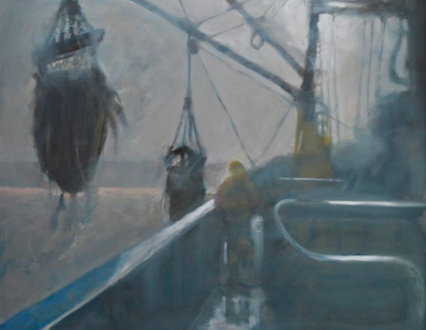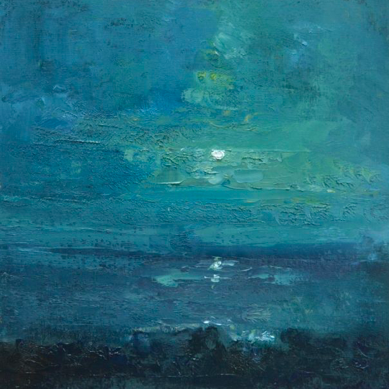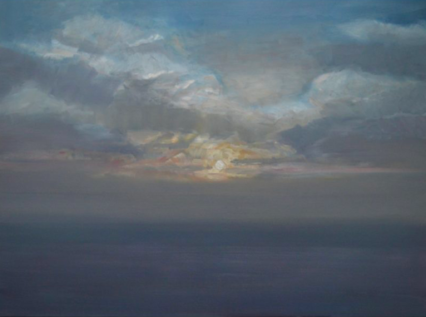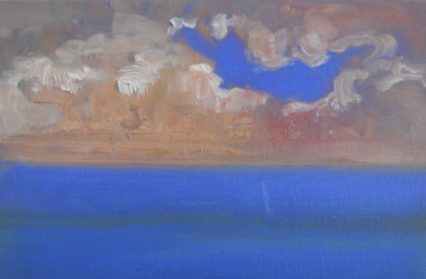James Lloyd finds presence through absence in Pete Jones’ exhibition, THE BAY, showing at Storiel, Bangor.
A sense of loss and longing appears as a veil through which we see the subject of Pete Jones’ oil paintings, the Hirael bay in Bangor; its tidal bays, infinite ocean horizons and the faces of those who lived there. THE BAY exhibition at Storiel Bangor explores Jones’ recollections of this area in which he grew up, of what was and is now gone, but also a symbolic sense of change and renewal.
There is the presence of people in the exhibition, yet they seem disconnected from the Hirael bay itself. In Codi’r cregyn gleision, the sun makes white the gunwale of the fishing boat, silhouetting the day’s catch. The fisherman is facing away, yellow jacket muted in shadow. It’s a beautiful painting, the first that caught my eye as I entered the exhibition. Like many of Jones’ paintings, it’s the stark contrasts between light and dark with flashes of colour that make them so striking. The whiteness of the light empties it of any warmth, a dying light that emotes the painting. Two nets of fish hang from a crane over the water; a good haul, yet there is no sense of celebration or victory. Like all the paintings, there is a soft focus, in this painting it seems to be from the sea spray and mist, that gives the sense of a faded memory. It gives the paintings this distance, as though what we see is out of reach.

The portraits of local faces also have this same effect. Figures fade into the darkness behind them, their expressions flat, their eyes sunken and hollow. Only The Last Mariner retains some glistening of the sea in his eye, a sea he is now removed from. The portraits are the fading memories of people who have passed on in some form, faces now detached from the place and fading into obscurity.
The sea is the real focus of this exhibition, the water that enabled Hirael Bay to have once been the largest slate port in the world. Every painting of its flat plain of ocean and distant horizon displays a different sunrise or sunset. Every painting shows a constantly changing landscape and emotion. In The Spilled Blood and the Wild Sky, a bright red horizon deepens into night, a hidden sun casts a fading reflection on a dark sea. Its bold use of red makes the painting visually arresting, in combination with its gold frame too pulls at something in me, I’m not sure what. There are nightscapes too, such as the white moon reflected back off the sea in Lleuad. This piece made me think of a comment by Van Gogh, that ‘the night is more alive and more richly coloured than the day.’ The stark white moon on the dark blues and greens of night is captivating. The painting is small, 46cx46cm, yet it draws you to its mystery and peace. Out alone in the dark while everyone else is inside, it can feel as though the moon shines only for you.

In Sgerbwd, the bay takes on the deep orange of sunset. In the foreground, the carcass of a boat on the flowered shore gives the painting a deep sense of loss and decay, a sentiment apparent in the similar Detritus and a theme that runs through the exhibition. As Pete Jones describes them as the ‘ribs’ of an old boat, the composition and subject reminded me of Gustave Guillamet’s desert painting Le Sahara, which depicts an animal carcass against an infinitude of desert. In Guillamet’s painting, an approaching group on the horizon cast long silhouettes across the desert, and similarly too in Sgerbwd the flowers seemingly growing from the carcass of the boat give the painting a sense of renewal from decay. Birds flash white against a pink sky in Hogia Hirael. The symbolic rising and setting of the sun, the transition between day and night in almost all of Jones’ paintings gives them the sense of constant change. The past is left to decay, but each day brings a new and unique beauty. In Mordaith, a pale sun slowly illuminates white clouds from a grey dawn over a calm hazy sea. The night still lingers, dark blue in the top of the frame, the sickle moon still lingering. Looking closer at the painting, you can see the whole circle of the moon in a brush stroke, the colour of night. In this period of transition there is harmony, balance.

The way Pete Jones paints is as though to see these landscapes, seascapes and people through a veil. A veil of loss and longing distorts the image, as though recalling a clouded memory written into the landscape, present in its absence. Yet there is hope too, a reassurance found in the sun rising and setting, the tides ebbing and flowing. As Pete Jones says, Monet saw the sea as a ‘symbol of the infinite.’ Perhaps of infinite space and far horizons, but also of constant change and renewal. The sun sets in Pete Jones’ paintings, but it also rises.
The Bay is showing at Storiel in Bangor until 31 December. More information available here.












